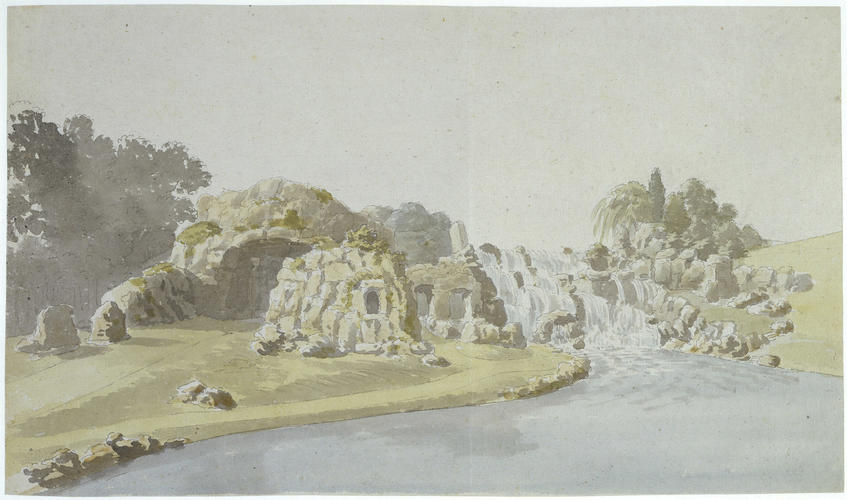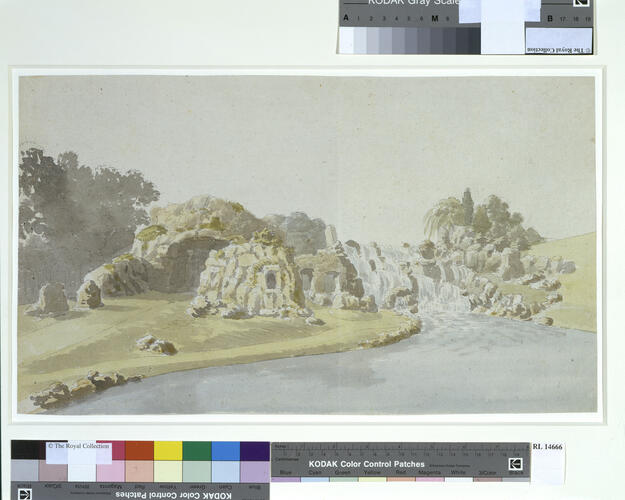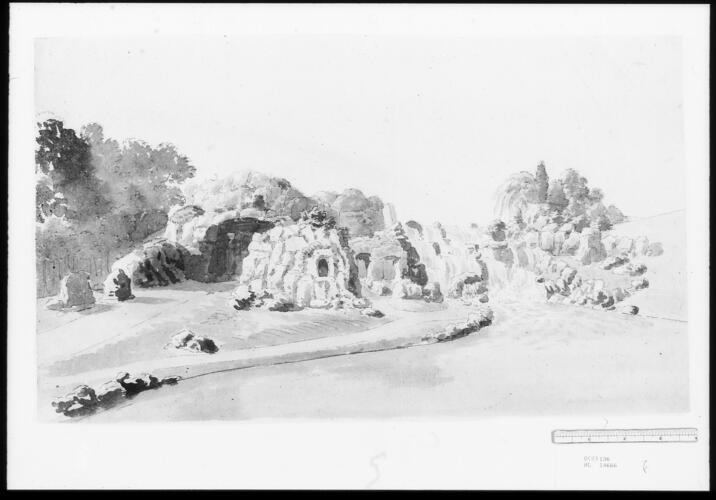-
1 of 253523 objects
A design for a grotto and cascade at Virginia Water c.1788
Pencil, pen and ink and watercolour | 26.5 x 45.7 cm (sheet of paper) | RCIN 914666
-
A pen and watercolour design for a grotto, waterfall and rockworks at Virginia Water.
Thomas Sandby was employed by William Augustus, Duke of Cumberland from 1746, first as Draughtsman, and from 1764 as Steward of Windsor Great Park, where the Duke had been appointed Ranger in July 1746. Sandby in effect acted as Deputy Ranger to both William Augustus and his nephew (and successor as Ranger), the King’s brother Prince Henry, Duke of Cumberland. He was resident in the Great Park for much of his adult life.
Sandby also worked as an architect. In the list of subscribers to Chambers’s Treatise of 1759 he was described as Architect to the Duke of Cumberland and he designed an extension to the Duke’s Windsor home, Cumberland Lodge, at around the same time. In December 1768 Sandby was appointed first Professor of Architecture at the newly founded Royal Academy and from 1770 he delivered a series of six lectures at the Royal Academy, which were repeated annually until his death. In 1777 he was appointed Architect of the King’s Works, with James Adam (brother of Robert), and from 1780 to 1782 he was a member of the Board of Works as Master Carpenter, a titular office. His work in St George’s Chapel in the 1780s and his design for a picture gallery at the west end of the North Terrace were probably associated with these appointments.
This drawing belongs to a group of designs by Sandby in the Royal Collection relating to various works carried out in Windsor Great Park. In 1750, the Duke of Cumberland created the artificial lake of Virginia Water. The architect for this project was Henry Flitcroft, although Sandby was involved in the Duke's never-completed plans to reinstall the Holbein Gate, which he had purchased after its removal from Whitehall, to a new location on the Long Walk in 1759. Sandby made more drawings for the Park after damage caused by floods in 1768 and 1782, and was responsible for the enlargement of the lake at Virginia Water and a new cascade and grotto. This drawing is probably related to Sandby's work at Virginia Water in the 1780s. There is a large number of drawings of rockworks relating to this period in the Royal Collection, with further groups at the V&A, Bodleian Library, and the Sir John Soane's Museum.
The original pondhead at Virginia Water, constructed in 1779, was destroyed by torrential rainfall in September 1768. The cost of repairing the lake would be considerable, especially because it would involve the diversion of the main road (the present A30) in order to secure the new pondhead. There is little evidence that Prince Henry attempted any reparations. However, in August 1781 the King himself announced that ‘the water in the Great Park and Windsor should be restored with considerable Improvements (which Improvements his Majesty has approved of . . .)’. Sandby was closely involved in the designs for these works. When the new pondhead collapsed soon after completion, he was nicknamed ‘Tommy Sandbank’. A stronger pondhead was then constructed, which incorporated a waterfall and grotto - similar to the original 1750s arrangement - as shown here. Work on the new pondhead and cascade was completed by the time of the King’s recovery and return to Windsor in March 1789.Provenance
Possibly acquired by George III; probably among the ’Various Sketches for Virginia Water‘ by Sandby noted by William Sandby in the Royal Library in 1892
-
Creator(s)
Acquirer(s)
-
Medium and techniques
Pencil, pen and ink and watercolour
Measurements
26.5 x 45.7 cm (sheet of paper)
Other number(s)
RL 14666


